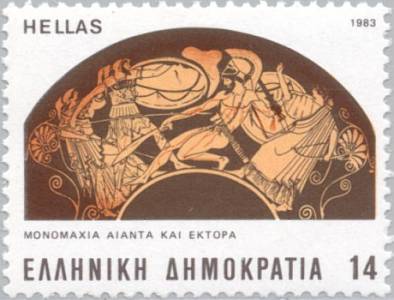.

The Trojan hero Hector and brother of Paris versus the Greek Ajax, the son of Telamon of Salamis
Ajax was after Achilles the best Greek warrior. He asked for the armor of Achilles after his death which he did not obtain. As the bravest was supposed to obtain the arms Ajax was surprised that they were given to Odyseeus. Ajax was very angry and he tried to kill Agamemnon. Athena intervened, he was struck by madness and he comitted suicide using his sword.
I heard a story of the Aeolians who afterwards settled at Ilium, to the effect that when Odysseus suffered shipwreck the armour was cast ashore near the grave of Ajax. As to the hero's size, a Mysian was my informant. He said that the sea flooded the side of the grave facing the beach and made it easy a enter the tomb, and he bade me form an estimate of the size of the corpse in the following way. The bones on his knees, called by doctors the knee-pan, were in the case of Ajax as big as the quoit of a boy in the pentathlon. Pausanias , Description of Hellas
Adrienne Mayor exaplins what maybe was found:
The second-century AD Greek geographer Pausanias described the excitement that surrounded the supposed discovery of the bones of Ajax. According to the Iliad, Ajax's grave was at Rhoeteum, where the Greek ships had landed to attack Troy. Bones of heroic dimensions were found and people took them to be the remains of Ajax. An eyewitness explained to Pausanias how the sea had washed out the beach, revealing a jumble of big bones. "Ajax's kneecaps were exactly the size of a discus for the boy's pentathlon," wrote Pausanias. A boys discus was about five or six inches across. Kneecaps big enough to be worthy of the hero Ajax would most likely belong to a Miocene era (ca. 8 million years ago) mastodon or rhinoceros; the remains of both animals have been found in the region around Rhoeteum.
Ancient accounts of the bones of heroes like Ajax, as well as giants and monsters from the remote past, can be explained by the presence of the fossil remains of mastodons, mammoths, giant giraffes, rhinoceroses, cave bears and other large animals found in the eastern Mediterranean region. Not suprisingly, modern paleontology demonstrates that prehistoric fossils exist in the very places where myths about giant beings first arose. As the Greek author Philostratus (ca. AD 218) remarked, it was logical to accept that "giants once existed, because their awesome remains could be seen all around the world."
| Ancient Greece
Science, Technology , Medicine , Warfare, , Biographies , Life , Cities/Places/Maps , Arts , Literature , Philosophy ,Olympics, Mythology , History , Images Medieval Greece / Byzantine Empire Science, Technology, Arts, , Warfare , Literature, Biographies, Icons, History Modern Greece Cities, Islands, Regions, Fauna/Flora ,Biographies , History , Warfare, Science/Technology, Literature, Music , Arts , Film/Actors , Sport , Fashion --- |

